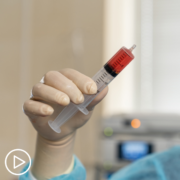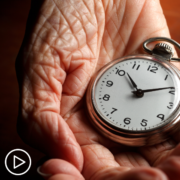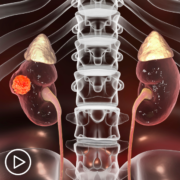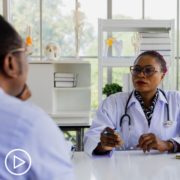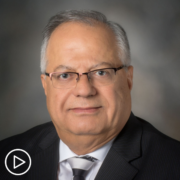CLL Patient Expert Q&A: Start Here from Patient Empowerment Network on Vimeo.
The START HERE program bridges the CLL expert and patient voice, whether you are newly diagnosed, in active treatment or in watch and wait. In this webinar, Empowerment lead Lisa Hatfield and expert Dr. Ryan Jacobs provide an overview of the latest in CLL, managing CLL side effects and options for CLL progression.
Dr. Ryan Jacobs is a hematologist/oncologist specializing in Chronic Lymphocytic Leukemia from Levine Cancer Institute. Learn more about Dr. Jacobs.
Download Resource Guide | Descargar Guía en Español
See More from START HERE CLL
Related Programs:
Transcript:
Lisa Hatfield:
Hello and welcome. My name is Lisa Hatfield, your host for this Patient Empowerment Network program. In this important dialogue, we bridge the expert and patient voice
to enable you and me to feel comfortable asking questions of our healthcare teams with more precision. The world is complicated, as is a cancer diagnosis, but understanding your CLL doesn’t have to be. The goal is to create actionable pathways for getting the most out of CLL treatment and survivorship. Joining me today is Dr. Ryan Jacobs, a CLL expert from Levine Cancer Institute. Thank you very much for joining us today, Dr. Jacobs, we really appreciate you being here and your time and expertise.
Dr. Ryan Jacobs:
Thanks for having me, Lisa.
Lisa Hatifield:
Before we get started, please remember to download the program resource guide via the QR code. There is great information there that will be useful during this program and after. Okay, let’s get started. So, Dr. Jacobs, I’d like to talk about what’s on the chronic lymphocytic leukemia radar, and rather than saying that entire phrase each time, I’m going to refer to it as CLL, because I’m pretty sure I’ll fumble that up. There’s a lot going on in terms of novel therapies and new options, but before we jump into all of that, the tool box that’s expanding, can you introduce CLL and provide an explanation of what it is and what that means for a newly diagnosed patient?
Dr. Ryan Jacobs:
So chronic lymphocytic leukemia, or CLL, is the most common chronic lymphoma/leukemia. It is really both most of the time. It presents with what we call lymphocytosis, meaning the white blood cell count, and specifically the lymphocyte count is high or elevated. To call it CLL, to make that formal cancer diagnosis, we can generally take a patient’s blood sample and put it through a fancy machine that we call a flow cytometer, that looks for characteristic markers on the outside of the cells, and if there’s a bunch of those cells, we call that a monomorphic population.
So a bunch of those cells that look the same, and they’re B cells, that’s the type of lymphocyte count they are, and they’re over this threshold of 5,000. Then that is the diagnosis right there, we don’t need an invasive procedure. You generally do not need a bone marrow biopsy or a lymph node biopsy. There is in about 15 percent of cases, the disease presents with just in large nymph nodes and the white count is normal. We call that small lymphocytic lymphoma. It’s considered an overlap with CLL, and I’ve had many patients that have started off with SLL and then eventually manifest elevated lymphocyte count later in their disease course. So it is considered an overlap, the treatment is the same for both of those disease entities.So that’s the diagnosis of CLL and how it generally shows up initially. In a nutshell, it’s a cancer of the aging population, average age is 70. I have a lot of patients that ask me, “Why did I get CLL?” And the answer is, we don’t know. It’s that way with most cancers, unfortunately, we don’t know why one person gets a cancer and the other person doesn’t. But it obviously has something to do with the aging effect on the DNA of the B lymphocytes because of how much more common it is as patients get older.
Lisa Hatifield:
Thank you for that overview, Dr. Jacobs. We do have CLL patients who are watching this who are newly diagnosed, they may be in active treatment, they may be in remission, they may be managing their CLL just fine right now in their lives. So we’re along the whole spectrum of CLL, so thank you for that overview. We know that therapies are evolving faster, hopefully faster than patients are relapsing, which is a good thing. So when they do relapse, chances are there will be a new option for this patient. But a CLL cure still remains elusive. So, Dr. Jacobs, if you can speak to…we’ll just jump right into some of the newer, the novel therapies and things that are being investigated with CLL treatment. If you can just speak to some of those newer therapies, the novel pathways and targets that are currently under investigation with CLL, we’d appreciate that.
Dr. Ryan Jacobs:
Sure. We’ve come a long way in how we are managing this common cancer that’s benefiting a lot of patients. And as mentioned, with this cancer being one that is more common in the older population, we do know that the population of the United States specifically is getting older, there’s going to be more 70-year-olds. So these breakthroughs are helping a growing number of CLL patients.
Before 2014, really outside of a clinical trial, the only way we could treat CLL Is with combinations of chemotherapy and an immune therapy, like a monoclonal antibody called Rituximab, that was kind of our first, what we would call targeted treatment outside of chemotherapy that we had, and it was, like targeted treatments are, well tolerated. It was an antibody that targets B cells specifically. So we were combining it with chemo, we would call that chemoimmunotherapy, and it helped a lot of CLL patients. But for many, those were poor prognostic markers in particular, and those with relapse disease, chemotherapy was not very helpful, and it was quite toxic in many circumstances. So we’ve been fortunate that since 2014, we’ve had a lot of new treatment options, and they’re targeted therapies. It’s not like non-specific cytotoxic chemotherapy, these are treatments that have been developed with specific targets in mind that are unique to the B-cell neoplasm, the B cell cancer, the CLL.
And the first of these that really changed everything was a BTK inhibitor called ibrutinib, that we got in 2014. Initially, we can only use it in the relapse setting, but eventually, in 2016, we could start treating patients as a first line of therapy with ibrutinib (Imbruvica). And then in 2019, we had a newer version of BTK inhibitor, we call those second-generation BTK inhibitors. That drug was acalabrutinib (Calquence). And it eventually was shown in a head-to-head study to be just as effective as ibrutinib in a relapsed patient population, but it had less side effects than ibrutinib. So in specifically, atrial fibrillation, hypertension. Cardiac toxicities overall were one that they really focused on in that study. So as a whole, when we were choosing BTK inhibitors, we were shifting away from ibrutinib, shifting to acalabrutinib, and then just as…earlier this year, we had a third BTK inhibitor, zanubrutinib (Brukinsa), that was approved. It’s also considered a second-generation BTK inhibitor like ibrutinib and acalabrutinib.
It treats CLL in the same way, in how it inhibits BTK or Bruton’s tyrosine kinase, that’s overexpressed in CLL cells. But it also has a favorable toxicity profile when compared head to head with ibrutinib, and now we have two second generation options between a acalabrutinib and zanubrutinib. And it’s not really easy for us to know between those two, which is “better.” When we decide to treat with a BTK inhibitor, we’re usually choosing between those two at this point, and we’re trying to personalize the decision for the patient, and there’s some different factors they can get involved in that complicated decision. Luckily, we are not limited to BTK as a target. I mentioned earlier, we have monoclonal antibody, rituximab (Rituxan) like the one I mentioned, but a newer version of Rituximab, a more potent version, obinutuzumab (Gazyva). Is one that we have available along with a Bcl-2 inhibitor, venetoclax. That is now, as of 2018, improved in the frontline CLL setting, also approved in the relapse setting, of course, since 2016.
And we use venetoclax with a monoclonal antibody like obinutuzumab, and together they are a very potent combination that cause pretty rapid cancer cell death, as opposed to the BTK inhibitors that more put the cancer to sleep and require daily dosing indefinitely for as long as the drugs work. And remarkably, the data on BTK inhibitors tells us that should work for many, many years. They’ve been following some of the patients that got treatment in the first line setting, and eight years out, there’s still more than 50 percent of the patients are free of progression, so they can’t even quote an average response time yet. With eight years of follow-up on the early ibrutinib patients. The difference with venetoclax combined with a monoclonal antibody like obinutuzumab, is because it causes a more rapid cell death, you can give it on a time-defined schedule. So we tend to give it for one year in the first-line setting and two years in the relapse setting, and the antibody portion is just given for the first six months.
The BTK inhibitors and venetoclax are oral treatments, so that’s a big win for patients to avoid the infusion center for those treatments, but the IV antibody treatments will still require some trips to the infusion center if you’re doing that combination with venetoclax. For most patients, those two targets are what we’re choosing between, and we try to personalize the decision to the patient. And again, that’s a very complicated discussion on what is “best”. And we use things like the prognostic work-up, medical problems that the patients already have, medicines that patients are on, to help make the best treatment decision for our CLL patients. But those…for in terms of how well that treats the CLL, both of those are considered equivalent options for the large majority of CLL patients. We’ve got some things on the horizon, but in general, those are two targets that we have at this point. There is for relapsed patients, PI3 kinase inhibitors that are still FDA approved at this time, that aren’t quite as effective and more toxic, so we sometimes think about using one of those targeted therapies if a patient has already progressed on a BTK inhibitor in venetoclax class.
In the future, we are looking towards combining BTK and Bcl-2 inhibitor. Like for example, there’s been studies already done that I’ve put many patients on, with ibrutinib-venetoclax, and I believe there’s a question about that later. There’s also an ongoing study that I have opened at my institution that’s looking at acalabrutinib and venetoclax. So taking these two pills together in a time-defined manner, so you don’t have to take the BTK inhibitor indefinitely. And then there’s some therapies that have already been improved in other lymphomas, and we wonder if they’re going to have a role in CLL eventually. So we now have bispecific antibodies, so that’s taking a drug like Rituximab or obinutuzumab and adding a T-cell engager to it so it has two targets or it’s bispecific. And we have that drug, mosunetuzumab (Lunsumio) available in follicular lymphoma, and there are several others in development, and we’ll see how their role comes into play in CLL as well. As well as CAR T-cell therapy, where we take a patient’s T cells and genetically engineer them to attack the cancer. That’s now an approved therapy for many different kinds of lymphomas and multiple myeloma as well. So we wonder if that’s going to have a role in CLL.
But I think for the foreseeable future, it’s going to be looking first at BTK and then Bcl-2 inhibition, or vice versa. And we don’t really know which is better to go first, we think they’re both…they can both be sequenced one after the other. And then maybe it will have some of these other breakthroughs coming in and helping for after patients need something beyond those therapies. And there’s probably going to be a lot of patients that never need anything beyond those options, those initial couple of targets, because they do so well. I think in the most immediate future, the approval that is going to give us a new great option is going to be for an alternative site BTK inhibitor, or it’s also called a non-covalent BTK inhibitor.
And there’s this drug called pirtobrutinib, it has been approved in mantle cell lymphoma and likely will get approved in CLL this year. And that drug specifically is a BTK inhibitor that still works even in patients that have, say, progressed on ibrutinib or acalabrutinib or zanubrutinib. That will be a new target available for CLL patients and probably pretty quickly become one of the go-to drugs that we use for relapsed CLL patients that have already been treated with a BTK…with a traditional BTK inhibitor. So growing number of options and it’s really great for our CLL patients.
Lisa Hatfield:
Thank you for that overview again, Dr. Jacobs. It does sound like there are a lot of new therapies coming out, especially for relapsed patients, super exciting for them. And this is actually a great time to jump right into questions. We have many questions from patients that different patients have submitted. But first, I want to remind everybody that this program is not a substitute for medical care. Please consult with your medical team for advice on your own condition or disease. And, Dr. Jacob, I was taking notes as you were talking, because you had spoken a little bit about a combination of the BTK inhibitor and Bcl-2 inhibitor with venetoclax. And I did a little research last night before I talked with you, and it sounds like that is something that the CAPTIVATE trial is investigating.
So that’s exciting, and a patient asked about that, what that trial is. And it’s music to my ears as a cancer patient to hear something like “fixed duration,” it’s also investigating a fixed duration so patients and have maybe a bit of a medication vacation. So can you speak to that trial a little bit and explain what it is a little bit on how that might benefit patients with CLL?
Dr. Ryan Jacobs:
Yeah. So one of the best elements of treating with venetoclax is that it produces a deep level of remission in many patients. In fact, when given with the monoclonal antibody obinutuzumab, to CLL patients receiving that treatment as a first line of therapy for their CLL, about three-quarters of CLL patients will get to so deep of a remission that we call them minimal residual disease-negative. And that’s a blood test or a bone marrow test, but more easily done as a blood test, where we can look to a sensitivity of one in 10,000 white cells and determine if there’s any CLL in those 10,000 cells. We can actually go deeper than that, but we say, we call patients negative if they’re less than one in 10,000. And so 75 percent of patients will get to that depth of remission just with obinutuzumab for six months along with venetoclax for a year. So when researchers saw that, they recognized that we could probably stop treatment in those patients getting venetoclax because venetoclax yields these deep responses. And then the next kind of thought was, well, could we give a BTK inhibitor with venetoclax, but also over a defined treatment timeline and maybe get some of the remarkable benefits of treating with a BTK inhibitor but not get stuck being on therapy for years and years.
So the CAPTIVATE study was the first really to, in a large Phase II manner, look at that combination in a younger patient population, it was for patients 70 and younger. And it wasn’t in a high risk or anything, it was all comers. But they did have to be 70 and younger and getting treatment as a first-line therapy. So the combination was very effective. As of the last American Society of Hematology meeting in December, four years of data was reported and a large percentage of patients were still free of progression, over 80 percent still free of progression. And that’s three years off therapy at that point.
It was well-tolerated, not many patients had to come off due to toxicity. It was, in fact, less than 10 percent had really significant toxicities requiring discontinuation. So it was a well-tolerated effective treatment.
I do have one of those studies to open at my institution, the acalabrutinib-venetoclax combination, it’s called the MAJIC trial, and it is a large Phase III study that if it’s successful, I think would lead to the approval of giving those two drugs together. But then the extra credit question is, who should get the combination and who should get the drugs separately? And we don’t have an answer for that right now, and that’s a long topic of debate among CLL specialists.
Lisa Hatfield:
Great. Well, thank you. So for that trial you spoke of that you’re conducting right now, is that…is it only relapsed patients who are eligible for that? Or is that for front-line therapy?
Dr. Ryan Jacobs:
No, this is a first-line therapy that the MAJIC study is.
Lisa Hatifield:
Oh good. That’s promising for patients too.
Dr. Ryan Jacobs:
And it has a really good comparator arm, so that won’t be a problem that the standard arm on that study is venetoclax plus obinutuzumab, so it’s comparing against one of our best treatments, and so we really will get the answer of does it look better to use the BTK with the Bcl-2? Or is it not really that much better than just giving an venetoclax with obinutuzumab? And then the one obvious element that I didn’t mention that would be nice for most patients in addition to being efficacious and well-tolerated is if you could get an all-oral combination. Of course, venetoclax with obinutuzumab, you’re still getting quite a few infusions with the obinutuzumab over the first six months. So that’s a lot of time in the infusion center that you could avoid with just the combination of two oral targeted agents. So that would be a breakthrough for patients too, I think.
Lisa Hatfield:
Well, you commented also on something that’s really important for patients to know, and that is that if you go into a clinical trial, you won’t be given nothing for cancer clinical trials, you’re going to be given the standard of care or whatever it’s being compared to. So for patients who are considering that.
Dr. Ryan Jacobs:
That’s a Phase III. Yeah, for Phase III. If you go on an earlier phase trial, you know exactly what you’re getting. There’s usually not any randomization for earlier phase studies, you just get the intended treatment.
Lisa Hatfield:
Okay, great. Well, thank you so much for explaining that. So we have some pretty specific questions, and we have a patient who wrote in and asked, “What is the difference between IGHV-mutated and IGHV-unmutated CLL? And can you talk about treatment considerations for those?”
Dr. Ryan Jacobs:
Yeah. So that’s part of a bigger discussion around the prognostic work-up of CLL and not all CLL is the same, and we’ve done a really good job of figuring out tests to separate out the CLL patients that tend to behave more aggressively and respond to certain kind of therapies, versus those that are more of what we call indolent or slow growing and respond to other kinds of therapies. I do want to say, I haven’t mentioned it yet, we still don’t treat CLL if it’s not causing any problems. And about half of patients get diagnosed as sort of an accident, and they get a blood test for something else, and their white count is elevated, and that leads to a diagnosis, but they feel fine. We still leave those patients alone. Even with these good treatment options we have, we recognize that there are a select percentage of CLL patients that don’t ever need treatment, and so we don’t just want to start treatment in everybody.
But I do still like to check this prognostic work-up, even if I’m not going to start treatment, but I make sure and ask the patient if that’s what…iIn line with what they want. But certainly, if you’re going to start treatment, you’re required by guidelines to check a prognostic work-up, and I would really encourage the CLL patients tuning in to ask their oncologist, “What is my prognostic work-up?” if they’re going to start treatment. Because of the oncologists, unfortunately, that have to deal with lots of other cancers, maybe don’t always know the right test to send. I’m very spoiled in that I get to just treat lymphoma and specifically focus a lot of my research in CLL and get to stay up with all this. I don’t know how a general oncologist keeps up with everything, honestly.
But the big three tests are going to be the FISH analysis, fluorescence in situ hybridization. And then IGHV mutational analysis, and then also a TP53 mutation analysis. And I don’t really have time to go through all of those, but IGHV is the question I get a lot. “What is that?” It’s one of these rare findings where it’s actually normal to have a mutation at the IGHV. IGHV stands for immune globulin heavy chain variable region, and it is usually mutated in B lymphocytes because it’s part of the process of a mature lymphocyte that is able to make a lot of different kinds of antibodies. And it undergoes somatic hypermutation, is what it’s called, as the B cell matures. Generally in oncology, the more mature a cancer is, the less aggressive it behaves and usually the easier it is to manage, and that is the case with CLL. So think of an unmutated IGHV CLL cancer as a more primitive or a more immature cancer clone, and as such, it is harder to treat.
In about half of patients will be found to be unmuted at the IGHV and historically, all we had was chemo and we knew these patients weren’t going to respond for near as long as the IGHV-mutated patients were to chemo. What’s nice is, with our targeted treatments, particularly the long-term data with the BTK inhibitors, it doesn’t look like it matters whether you’re mutated or you’re unmutated. So that’s one of the really great things with our new treatments for CLL, is it has, the people that have benefited the most are the ones that were doing the worst, so that’s great. It’s not just the patients that were already doing well, that are doing even better.
Lisa Hatfield:
So I just want to take a step back and kind of looking at this through the lens of a newly diagnosed CLL patient. You’d mention that sometimes you don’t treat every CLL patient. So is there something, if you find a patient who does not need treatment, is there something you tell the patients as far as regular monitoring? Will you monitor them to see if it progresses to the point where it requires treatment?
Dr. Ryan Jacobs:
Yeah. And we’re fortunate that this is a blood cancer that most of the time we can follow with a simple blood count and follow the white count, follow how the…follow the health of the bone marrow by looking at things like anemia, low red cell count, or a low platelet count that we call thrombocytopenia. So that’s the easiest thing to follow, but I’m also talking with my patients and examining my patients. I want to know if their length nodes are causing them a lot of pain, because we should treat that, there’s no reason they should live in pain.I want to know if they’re waking up drenched in sweat all the time, if their quality of life has been really affected by that. Or are a dramatic amount of fatigue that we can’t explain by some other cause. And I also, of course, examine the nodes myself and make sure that there’s no alarming findings there. So that’s really what’s involved with checking on a CLL patient that’s on active surveillance, that’s what we call it. And there’s a list of criteria that the oncologist should know in terms of deeming who needs treatment and who doesn’t. And so we’re kind of following the same rules, so to speak, in terms of who gets treated for CLL.
Lisa Hatfield:
Okay, thank you. So we have a patient who asked a series of questions here, and I think you already…you spoke pretty well to the role of the BTK inhibitors in treating CLL. I’m going to kind of clump these together. So I guess three questions. What treatments do you think are the most beneficial for patients whose CLL has relapsed? What are the poor prognostic indicators for CLL? And along the same lines, what are the high-risk genetic markers for CLL?
Dr. Ryan Jacobs:
It’s a little more complicated discussion in the first line setting because both are options. At this point in time, we haven’t been…at least those that are, I would say, staying up to date on the CLL data, we have not been using chemotherapy for a long time. So most of the relapsed patients will have seen either one of the BTK inhibitors or venetoclax. And so what we do in the second-line setting is just use the other option that they haven’t seen. The data tells us, when you look at what treatments are being prescribed, most patients are going on BTK inhibitors, and they have been around longer than venetoclax in general. So for a lot of patients, that relapsed treatment is going to be venetoclax. Because that has the best data in terms of treating patients that have progressed on a BTK inhibitor like ibrutinib or acalabrutinib or zanubrutinib.
In the near future, we’ll have pirtobrutinib (Jaypirca) and so maybe, maybe some will get that drug before venetoclax, and that’s probably okay. And so we’ll have that additional option. The complicated patients, and I’ve alluded to this, or what do we do after BTK and Bcl-2? What are we left with? I mentioned PI3 kinase, that’s not a great option. There’s still stem cell transplant out there for young patients that are running out of options. Clinical trial is really what I would like to emphasize there. If you’re a patient that can get to a high volume referral cancer center with a CLL specialist, I would do that. If you have seen BTK inhibitor and venetoclax and are looking for other options.
Lisa Hatfield:
Great, thank you. So the next question is actually a really good question, I think we can broaden it a little bit. But the question is, “How can I ask my doctor to make sure I am being tested for serum markers?” And more broadly, I think a lot of patients are a little bit nervous about asking questions of their doctor, because they don’t want to feel like they’re questioning their expertise or doubting them. So how in general can we ask our doctor questions if we hear something? Or how we approach our doctor with those types of questions?
Dr. Ryan Jacobs:
So I mentioned asking your doctor, “What’s my prognostic markers?” I think this is probably the easiest way to get that information. And your doctor should be checking those. The question comes up like, what are the “high-risk” markers? We talked about mutated versus unmutated. Thankfully, our novel treatments that doesn’t seem to matter. Same goes with…there’s on FISH there used to be, if you found three copies of chromosome 12, that’s called trisomy 12, that doesn’t seem to matter With our newer treatments. A deletion at chromosome 11, again, used to not do as well with chemo. Novel therapies…doesn’t seem to matter. The one that is still potentially affecting outcomes, even with our novel treatments, are chromosome 17 aberrations, which stately are rare in the initial diagnostic setting. That or a TP53. A deletion at 17p or TP53 mutation probably is only going to be around 10 percent of patients or so. And in the relapse setting though, that number goes up because of the more aggressive cancers emerge, we call that clonal evolution. So maybe in the 20-ish percent range. These patients, we tend to prioritize indefinite therapies first, because it seems like these patients do better if you keep treatment going, as opposed to interrupted therapies like venetoclax. And so we tend to treat those patients with a drug like acalabrutinib or zanubrutinib first and then think about the venetoclax later for those patients.
Lisa Hatfield:
Okay. Okay. And just to clarify, for patients too, I know that a lot of cancers, there are discussions about the 17 deletion, 17p, and then also the TP53 gene. So if I understand correctly, the TP53 gene is housed on chromosome number 17. So if that is missing, then that patient may be missing that gene, that is considered a tumor suppressor gene, which we want. Is that correct?
Dr. Ryan Jacobs:
Right. So it’s either missing, which is what we see on FISH with a deletion, or it can be mutated and that’s the next gen sequencing, and often it will be both in those patients.
We think with indefinite, there’s some really good data that was just released with zanubrutinib. When they looked at 17p-deleted patients, there’s some long-term follow-up with ibrutinib-treated 17p-deleted patients. With chemo these patients would only get about a year or so, but we’re getting maybe even close to normal outcomes with long-term BTK. But we do know if you just give them a year of venetoclax and obinutuzumab for six months and then stop, they do relapse quicker than the other patients. So they relapse after about four years. As opposed to with five years of follow-up with that first line venetoclax approach, there are 62 percent of patients are still free of progression.
Lisa Hatfield:
Oh wow, okay. Thanks for explaining that too. I know that that chromosome 17 and the TP53 gene, that’s talked about in a lot of different cancers and it often come up, “How are those connected?” So thanks for just describing that a bit. So this patient is asking, “For patients who may be eligible for BTK inhibitors, are there specific comorbidities that might contribute to adverse side effects?”
Dr. Ryan Jacobs:
Yeah, so we screen…all BTK inhibitors have some cardiac toxicity. They have been shown with the second-generation BTK inhibitors to have less cardiac toxicity than ibrutinib, specifically atrial fibrillation. So if you have atrial fibrillation, maybe that’s a reason why you might go on venetoclax first as opposed to a BTK inhibitor. But it’s not a contraindication to getting a BTK inhibitor if the atrial fibrillation is under good control. Other cardiac risk factors would include difficult to control hypertension at baseline, or heart failure. These are all things that might make us think twice about using a BTK inhibitor as our first therapy, because venetoclax has no cardiac toxicities. The other thing to consider is BTK inhibitors all to a degree have, and I describe it to patients, like an aspirin-like effect on the platelets. They do interfere with the platelet binding, which so universally, patients will know to varying levels some easier bruising.
And if patients are on, because of say, they’ve had a heart attack in the past and they’re on aspirin at baseline, or what would even be more concerning if they were on a drug like Plavix because they’ve had a stent placed, that would be something that would really concern me and would definitely push me more towards venetoclax, that again, doesn’t have those anti-platelet interactions. Also, patients who are on blood thinners because of a history of blood clot or atrial fibrillation, there is the potential increased risk for bleeding and bruising there as well. None of these are absolute contraindications, they’re just all what goes into the blender, if you will, of putting lots of information in and coming up with the best treatment decision as personalized for the CLL patient. We’re blessed to have multiple options, but it does make it more of a challenge to find the “best” option.
Lisa Hatfield:
Yeah. Thank you for that. We have several questions from a couple of patients regarding side effects. So the question, “How long will my side effects of my CLL treatment last? And what can be done to reduce those?” And specifically, a patient is asking if there’s a connection with CLL and gastrointestinal issues?
Dr. Ryan Jacobs:
So all of the treatments, including venetoclax, the BTK inhibitors, will have diarrhea listed as a possible side effect. It’s usually low grade. But generally, I have found the gastrointestinal toxicities abate some over time. So if they are present earlier, if you’re able to stick with therapy, they do tend to get better. For the once daily meds, I encourage those patients to try to take the drug in the evening. The GI tract tends to be less active later in the day, and you can sleep off some of the potential gastrointestinal issues. So I’ve had success there. Sometimes we have to lower the dose to just find the best dose to help mitigate some of these. There’s the antidiarrheals that can help if you need them. Imodium. I had a patient I saw earlier this week that Imodium didn’t really work, but good old Pepto Bismol did the trick from time to time. So certainly though, if the gastrointestinal issues are significantly affecting quality of life, we need to come up with a new plan, whether that’s reducing the dose or changing to a different option. Specifically, what’s nice about the BTK inhibitors is they all have data that show if you’re having problems with one, you can switch to the other and likely not have the same problem occur. So that’s nice.
Lisa Hatfield:
Have you ever seen any uncharacteristic side effects several times in your practice? Anything really unique? I’m just curious about that.
Dr. Ryan Jacobs:
Yeah. There’s always the patients, they can have a more severe form of maybe, of a more common side effect, like the…we were talking about diarrhea, I’ve had a patient that actually had a difficult, with venetoclax, had difficulties with the stool incontinence. So that was kind of a severe form of that. It wasn’t so much diarrhea that was the problem. But we were able to ultimately mitigate that with a dose reduction. I would say the way, particularly if it’s an unusual side effect, the best thing to do is to take a break. If it’s a serious side effect that needs to be addressed and it’s affecting quality of life or causing problems, take a break from the treatment. If you take a week off these treatments, particularly venetoclax, taking breaks doesn’t matter. We like not to take long breaks with the BTK inhibitors. But if you take a week off, these drugs don’t have very long half-lives. So if the issue is not getting any better and you’ve been off of treatment for a week, it’s unlikely that that issue is coming from the treatment. So that’s a way I try to sort through some…particularly if they’re unusual side effects sometimes. And certainly, if we deem that the issue is connected to the treatment, I’ll usually try lowering the dose before just giving up.
Lisa Hatfield:
Okay. Thank you. A patient had asked, and I love this question because I often wonder myself when I get up in the morning, my bones are creaking and popping, “How do you know the difference between,” this patient’s talking about fatigue. How does a patient discern, “Well, this is fatigue from my cancer or my treatment,” versus just normal aging? Whether it’s fatigue or bruising or any side effect.
Dr. Ryan Jacobs:
Yeah. Fatigue is a really…I had an attending physician when I was in my training that said, “Treating fatigue makes me fatigued.” But it’s hard. If it’s really the only problem the CLL patient is having, it can be. All those other problems I had mentioned earlier, the low red cells, the low platelets, the painful nodes, the night sweats, I with close to 100 percent certainty know I can fix those with treatment.Fatigue, I’m not as confident when that’s the only issue that a patient’s having. I try to differentiate between fatigue from other causes and old age, and specifically to CLL.
They try to put it as a metric and say, if you’re having to spend half the day or more just lying around and you’re not able to do your normal activities of daily living, like that’s a severe level of fatigue and treatment should be considered.I’m looking for somewhat of a precipitous decline, not necessarily just kind of the gradual fatigue that you might more relate to aging. The problem with treating fatigue is you’ll look, if you look at the possible side effects of all of these medicines I talked about, fatigue will be a potential side effect.So you’re sometimes trading one problem and getting another, or maybe the fatigue does get better, but then the patient has some different side effect that’s even worse than the fatigue. So it’s hard to really help when fatigue’s the only issue. But certainly, I have helped some patients with fatigue. We don’t have a test that we can do to know for sure is the fatigue coming from the cancer, or is it coming from something else.
Lisa Hatfield:
Great. Well, that wraps up our program for today. Thank you so much for joining us, Dr. Jacobs. I am Lisa Hatfield from Patient Empowerment Network.
Share Your Feedback
Create your own user feedback survey
